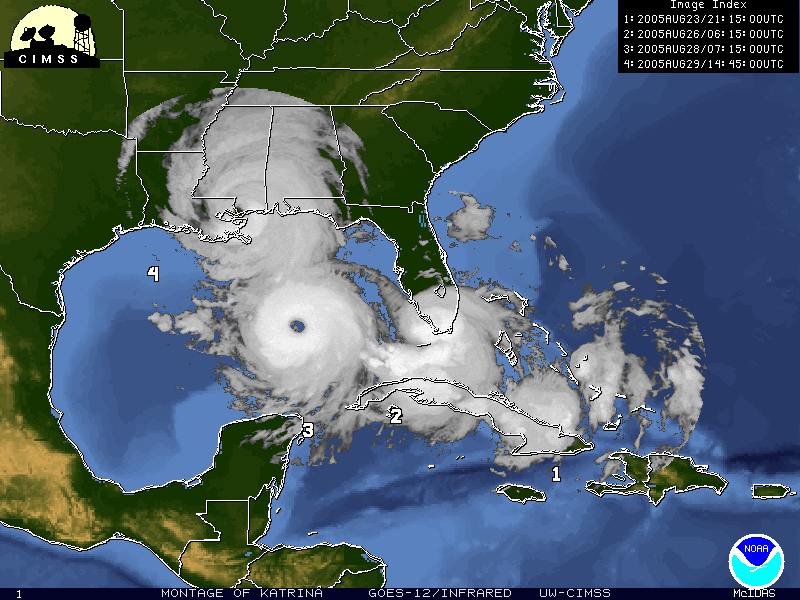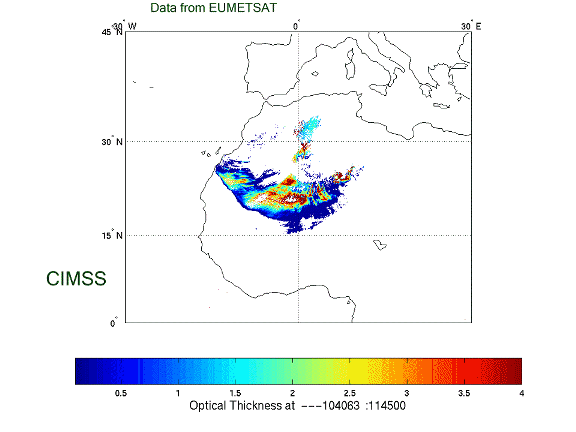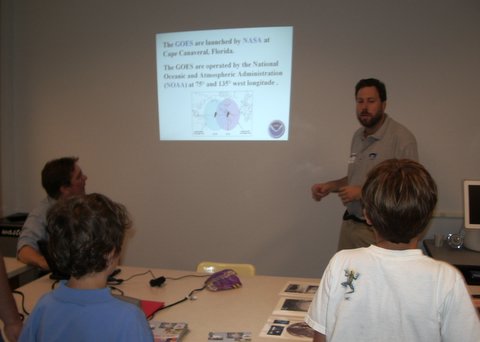 |
CIMSS-NOAA Weekly Report
[ Archive ] |
 |
ASPB AND CIMSS WEEKLY HIGHLIGHTS FOR THE WEEK ENDING SEPTEMBER 2, 2005
IN
THE PRESS:
ITEMS
FOR THE ADMINISTRATOR:
ITEMS
FOR THE ASSISTANT ADMINISTRATOR:
ITEMS
FOR THE OFFICE DIRECTOR, STAR
Tropical Cyclone "Montage Image"
Product of Katrina: The Cooperative Institute for
Meteorological Satellite Studies (CIMSS) Tropical Cyclone Research Team
has generated a "hurricane montage" product that displays the path of
each tropical cyclone using snapshot images of the storm during its
lifetime. As the storm traverses the ocean basin the montage procedure
will continually modify the areal coverage of the display region to
capture the lifecycle of the cyclone as it develops. The
product is available on the CIMSS Tropical Cyclone Webpage in real-time
along with an archive of the various montage images for selected storms
worldwide. The montage archive can be found at http://cimss.ssec.wisc.edu/tropic/archive/montage/montage.html.
(T. Olander, CIMSS, 608-265-8005)
 (Click image
to enlarge)
(Click image
to enlarge)
Satellite Imagery of Hurricane
Katrina: Geostationary Operational Environmental Satellite
(GOES) imagery of Hurricane Katrina was posted on the Cooperative
Institute for Meteorological Satellite Studies (CIMSS) GOES Gallery (http://cimss.ssec.wisc.edu/goes/misc/050829/050829.html).
On August 27 (a day prior to the period of rapid intensification to
Category 5 strength) GOES-12 Rapid Scan Operations imagery indicated a
series of convective bursts near the center of the storm, followed by
rapid axisymmetrization of these features as they wrapped around the
eye. GOES wind shear derived products also showed that the hurricane
was moving into a low shear environment, a factor that was conducive to
further intensification. (S. Bachmeier,
CIMSS, 608-263-3958)
Visiting Scientist from Korean
Meteorological Administration Arrives in Madison: O-Ung
Kwon arrived in Madison, WI, this week to begin a two-year
visit with the Advanced Satellite Products Branch (ASPB) and the
Cooperative Institute for Meteorological Satellite Studies (CIMSS). He
is with the Remote Sensing Division of the Korean Meteorological
Administration (KMA). Mr. Kwon will be working on several science
issues associated with Geostationary Operational Environmental
Satellite (GOES)-R. (T. Schmit, E/RA2,
608-263-0291, tim.j.schmit@noaa.gov)
Visiting Scientist from National
Satellite Meteorological Center (NSMC) of China: Peng
Zhang from the National Satellite Meteorological Center (NSMC) of China
is completing his seven month visit to the Cooperative
Institute for Meteorological Satellite Studies (CIMSS). Part of his
work dealt with improved detection and characterization of dust from
thermal infrared measurements. This consists of generation estimates of
the dust optical thickness and effective radius of dust particles from
both polar and geostationary satellite data. (T. Schmit, E/RA2,
608-263-0291, tim.j.schmit@noaa.gov)
 (Click image to enlarge)
(Click image to enlarge)
Figure caption: Dust optical thickness retrieval derived from hourly
EUropean organization for the exploitation of METeorological SATellites
(EUMETSAT) Meteosat Second Generation (MSG) measurements over Sahara
region. The dust evolution is well depicted by high spatial
resolution geostationary imager data.
ITEMS
FOR THE DIVISION CHIEF, CoRP
National Weather
Service Course on Management and Supervision: A.
Heidinger attended a two-week course on management and supervision held
at the NOAA National Weather Service (NWS) training facility in Kansas
City, Missouri. The course provided training on methods of
effective communication, strategies for handling troublesome employees
and situational leadership. In addition, specific instruction
was provided on NOAA's human resource, union relations and media
relations policies. (A. Heidinger, E/RA2,
608-263-6757, andrew.heidinger@noaa.gov)
Space
Place Open House: A slide show was developed and given at
the University of Wisconsin-Madison Space Place open house on August
28, 2005. The presentation consisted of an overview of the
Geostationary Operational Environmental Satellite (GOES), satellite
images of the storm that spawned the recent F3 tornado in Stoughton,
WI, and a near-real time look at Hurricane Katrina. The
presentation is available upon request. More information on the space
place can be found at http://www.spaceplace.wisc.edu.
(T. Schmit,
E/RA2,
608-263-0291, tim.j.schmit@noaa.gov, J. Nelson, CIMSS,
608-263-6013)
 (Click image to
enlarge)
(Click image to
enlarge)
Student Presentation on Model
Validation: Alex Harrington, an undergraduate
senior at the University of Wisconsin, Madison, recently presented the
results of his research project at the 15th annual Wisconsin Space
Grant Consortium (WSGC) conference in Madison. His project,
funded by the WSGC, was titled “Validating CIMSS Regional
Assimilation System (CRAS) Forecasted Satellite Imagery Using
GOES”. Mr. Harrington was able to identify biases
in the CRAS moist physics by comparing model forecasted brightness
temperatures to observed brightness temperatures from the GOES
sounder. The project was carried out over a two year period
under the guidance of R. Aune. (R.Aune, E/RA2,
608-262-1071, robert.aune@noaa.gov)
Journal Paper Review: T.
Schmit reviewed a manuscript for the Journal of Geophysical Research
- Atmospheres. (T. Schmit, E/RA2,
608-263-0291, tim.j.schmit@noaa.gov)
Other Meetings and Telecons:
(None)
VISITORS:
NEXT WEEK:
LOOKING AHEAD:
Archived Weeklies Page




 (Click image
to enlarge)
(Click image
to enlarge) (Click image to enlarge)
(Click image to enlarge) (Click image to
enlarge)
(Click image to
enlarge)